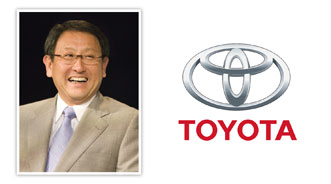Auto Industry Continues to Pour Out Support in Response to Quake

The Pacific quake and tsunami have wrecked havoc upon parts of Japan and danger continues to loom as at least three reactors were significantly unstable as of press time and government officials were urging many in impacted parts of the country to stay inside to avoid possible radiation exposure. But the disaster has also brought to light another potential challenge, albeit one not life threatening. If Japanese automakers are unable to keep up with inventory demands in North America as much production has halted, will U.S. sales continue to grow for these brands?
In light of this tragedy, automakers have poured out their support — both financially and with words of encouragement, condolence and solidarity — and provided updates as to the safety of their employees and where their operations in Japan currently stand. At least one has reported casualties.
Toyota
Beginning with Toyota, its North American leadership said that the automaker would be suspending production at all its Japanese plants (including all subsidiary plants) through today.
The automaker also posted a statement from Toyota Motor Corp. president Akio Toyoda.
“I offer my prayers to all those who lost their lives in the March 11 Tohoku Earthquake and its ensuing aftermath, as well as my sympathy to the survivors and their families,” he said.
“Not only is the struck region one of our production bases, those directly hit and vastly affected include our dealers, suppliers and numerous other partners,” Toyoda added. “With life the number one priority, we want to do all we can to contribute to the relief efforts.
“Determined to provide hope for not only those suffering and forced to undergo extreme hardships, but also for the region overall, we will do our utmost toward the realization of recovery,” he continued.
On Sunday, Toyota said there had been no reports of injuries “at Toyota operations, including the Tokyo head office, the Higashifuji facility, Tochigi office, Yamanashi office, Toyota Motor Tohoku facilities and at TMC subsidiary vehicle manufacturers.”
Officials also noted: “We are now conducting a detailed survey of each plant to determine the extent of any damage. We are also currently assessing the situation at our suppliers, dealers and the impact on North American import vehicles.”
The company reported Sunday that TMC. also was “moving to donate” about $3.75 million to aid in relief and recovery.
Mazda
Moving over to Mazda Motor Corp., it said in a statement Tuesday that it was extending the temporary production halt at its Hiroshima and Hofu plants. The company had said Monday that it would be stopping production at the facilities beginning with that night’s shift through Wednesday night’s shift, but ultimately chose to push the delay back to Sunday.
Beyond that, Mazda said it will provide updates as they become available.
“Mazda Motor Corporation wishes to convey its heartfelt sympathy and concern for all people affected by the major earthquake in eastern Japan,” it noted.
“Mazda places the highest priority on ensuring the safety and wellbeing of its suppliers, their employees and their families, in the affected region. In consideration of this, and as part of the recovery efforts underway throughout Japan, Mazda will extend the production suspension at its Hiroshima and Hofu plants until March 20,” the company shared.
Mazda revealed Monday that it would be giving 30 million yen in aid to the region in an initial response. It said the automaker will offer goods or personnel where necessary.
Nissan
Moving along, Nissan Motor Corp. also offered an update on Monday.
“As an update to previous reports regarding the recent earthquake’s impact to Nissan and our affiliates’ facilities, the following is the latest update on our manufacturing operations,” the company noted.
“Additionally, taking into account the severity of the situation, Nissan will make its utmost efforts to provide support to restoration activities. Fully cooperating with the government’s request to place national priority on securing electricity for areas in need, Nissan and its group companies will proactively take measures to conserve electricity usage in all of its activities.
The automaker revealed that it would be temporarily stopping operations at its Tochigi and Iwaki plants until Friday, while activity will be suspended until today at the Oppama, Kyushu, Nissan Shatai, and Yokohama plants.
On the humanitarian front, Nissan is pitching in 30 million yen to the NGO Japan Platform and also has several more charitable options on the table.
Furthermore, Nissan listed several “Electricity Conservation Activities” that it would undertake, as follows:
—Suspension of air-conditioning at Global Headquarters (GHQ) and Nissan Technical Center.
—Closure of all “Nissan Gallery” locations in Japan (GHQ, Sapporo, Ginza (Tokyo), Nagoya, Fukuoka) until Friday.
—Blackout of all dealership signboard lamps and lowering of lighting intensity inside showrooms.
Additionally, Nissan Americas provided updates regarding employees and facilities in Japan, as well as the vehicle stock/sales impact.
Beginning with employees, the company noted: “All Nissan Americas employees and their families are safe and accounted for, including those on assignment in Japan and those traveling in the country on business. Some Nissan Americas employees who were traveling in country on business have already returned to their home countries while others are in the process of returning.”
Moving over to facilities, Nissan Americas stressed that all its manufacturing facilities are open and running and “will continue normal production schedules until further notice.” However, the company did note that six Nissan facilities in Japan have seen building or equipment damage.
Specifically, those are the following: Iwaki Plant (Iwaki City, Fukushima Prefecture), Tochigi Plant (Kawachi County, Tochigi Prefecture), Yokohama Plant (Yokohama City, Kanagawa Prefecture), Oppama Plant (Yokohama City, Kanagawa Prefecture), Zama Operations Center (Zama City, Kanagawa Prefecture) and Honmoku Wharf (Yokohama City, Kanagawa Prefecture).
As far as vehicle stock/sales, Nissan Americas stressed that: “Nearly 70 percent of the vehicles Nissan Americas sells in the region are produced in the region and manufacturing operations are continuing to operate on a normal schedule.
“In general, Nissan Americas is operating with a sufficient days’ supply of vehicle stock on the ground in the region or already in transit from Japanese ports,” the company noted.
The company did point out that there was some damage to various units at the Port of Hitachi and Ibaraki Prefecture headed to the U.S. and Canada, as well as other units stored at the Miyagi Service Center.
“Some Infiniti models and Nissan GTR and 370Z may experience delays in shipment to the U.S. and Canada with full impact still being assessed,” the company added. “A shipment of more than 600 Nissan LEAFs destined for the U.S. left port in Japan on March 10, just prior to the earthquake, and will arrive as scheduled. Future impact, if any, on Nissan LEAF supply continues to being assessed.”
Offering some insight to that final item, John O’Dell, the senior editor of the GreenCarAdvisor.com from Edmunds.com, noted: “Nissan executives promised that the supply of Leaf EVs in the U.S. would increase markedly by April, and it looks like it’s a promise they’ll be able to keep since a shipment left Japan just prior to the catastrophe.”
Honda
Next up was Honda, which confirmed recently that a 43-year-old male R&D associate died at the Tochigi R&D Center as a wall fell in the center’s cafeteria.
The automaker also confirmed 17 injuries to Honda employees in the Tochigi area due to collapsing ceilings and other effects of the quake. Early reports had indicated the injury toll at 30, Honda explained.
Production is halted through Sunday at the following facilities: Sayama Plant at Saitama Factory (Sayama, Saitama), Ogawa Plant (Ogawa-machi, Hiki-gun Saitama), Tochigi Factory (Moka, Tochigi), Hamamatsu Factory (Hamamatsu, Shizuoka), Suzuka Factory (Suzuka, Mie), and Kumamoto Factory (Ozu-machi, Kikuchi-gun, Kumamoto).
“Honda is cooperating with electricity conservation efforts and rolling blackout measures, prioritizing the relief and recovery of affected areas,” officials explained.
Honda in Japan has given relief and recovery efforts 300 million yen as well as 1,000 generators and 5,000 gas canisters. Honda’s staff will also go out offer instruction on using the generators and gas canisters.
“The Honda family of companies in North America will establish special matching gift programs for their associates for donations to the Red Cross to aid the victims of the earthquake and tsunami in Japan. Donations from associates will be matched on a dollar-for-dollar basis, with no personal or corporate donation limit,” officials noted.
Discussing the North American impact in further detail, Honda explained that it has “confirmed the wellbeing of all Honda associates on assignment in Japan from North America.
“There is no immediate impact on Honda’s operations in North America. More than 80 percent of Honda and Acura products sold in the U.S. are produced in North America, and the vast majority of automotive parts for Honda automobiles manufactured in North America are sourced in the region,” it continued.
The automaker added: “Honda is assessing the long-term impact on Honda auto production in North America, since some auto parts are supplied from Japan.
“We currently have adequate inventory of products supplied from Japan, both in inventory and in transit from Japan,” officials shared. “Honda Fit, Insight, CR-Z, Civic Hybrid, Acura TSX and Acura RL are produced in Japan for the North American market. Honda produces a small percentage of CR-Vs in Japan for the U.S. as well.”
Other Donations
Moving along, it was revealed that other auto-related companies have thrown their support into the recovery efforts.
JPMorgan Chase, which operates vehicle financer Chase Auto Finance, said Monday it had pledged $5 million to the relief and recovery efforts. The bank was also urging employees to donate to the American Red Cross and World Vision and said it would match whatever its employees gave.
“Our thoughts and prayers are with the people of Japan at this time,” stated JPMorgan Chase chief executive officer and chairman Jamie Dimon said. “This donation is to help both with immediate needs as well as the ongoing relief and recovery efforts in the months ahead.”
Meanwhile, the General Motors Foundation gave $250,000 to the Red Cross as a supporting member of the Disaster Responder program. It then topped that Monday with its approval of a $500,000 immediate donation from the GM Foundation to the Red Cross’s relief fund for Japan.
“Humanitarian relief is an important part of the Foundation’s work and we’re answering the call for help in the wake of such terrible devastation,” stated John Montford, who is the chairman of the GM Foundation and senior advisor for government relations and global public policy. "There is remarkable compassion among GM employees, and I know that same spirit will make a difference in helping the Japan relief effort."
CNW Gauges Supply-Chain Impact
In light of the production suspensions, CNW Research set out to determine what the impact may be here in the U.S. market.
The firm suggested that disruptions in the supply chain typically to immediate effects. It appears that while U.S. shoppers considering Japanese brands could be willing put off their purchase for a short term, there likely would be a dramatic downward impact on loyalty following a 90-day delay.
“Here’s what we know as of (Tuesday) morning. Because Toyota, Nissan and Honda work on a tight supply chain, disruptions — and there are obviously many — are felt quickly. Certainly within 45 days,” explained CNW president Art Spinella.
“This impact, not only the vehicles built in Japan and shipped to the U.S., but vehicles assembled here with critical imported components,” he continued. “A quick-poll of Japanese brand intenders as to how long they would be willing to wait for a vehicle if their first choice is not available for 45, 60 and 90 days shows fairly uniform intent to wait upwards of 90 days.
“Deterioration of the brand’s loyalty at 90 days is significant, however …,” he stressed, noting, specifically, that a 90-day wait would mean a 14-percent drop for Toyota loyalty, a 19-percent decline for Nissan loyalty and an 8-percent decline for Honda loyalty.
Edmunds Analysts Chime In
Moving along, several analysts with Edmunds.com weighed in on Tuesday as to how the disasters’ aftermath may impact the industry.
“The U.S. market appears sufficiently stocked to weather a temporary disruption of imported models, said Michelle Krebs, senior analyst with Edmunds.com. “The majority of Japanese brand cars sold in the U.S. (67 percent) are also produced here in North America.
“An estimated 79 percent of Hondas sold in the U.S. are produced in American plants; for Toyota it’s 72 percent, Nissan is 65 percent. At the other end of the spectrum, only 8 percent of Suzukis sold in the U.S. are produced in America, as are 16 percent of Mazdas,” she continued.
The impact may also reach into sale dynamics relating to gas-price trends, one Edmunds analyst suggested.
“Japanese hybrids and small cars, with few exceptions, are produced in Japanese plants. With rising gas prices in the U.S., demand for fuel-efficient vehicles will likely increase and automakers who have supply will reap the benefits,” said Jessica Caldwell director of pricing and industry analysis for Edmunds.
Continuing along, Bill Visnic, senior editor of Edmunds’ AutoObserver.com, offered some insight on the impact in Japan. He noted: “While most automaker assembly plants escaped serious damage, less detail is known about the state of Japan’s vast and fragmented supplier base.
“It is the disaster’s effect on those operations — and the connected logistics — that ultimately will dictate when automaker production resumes normalized activity,” Visnic added.
Offering some perspective on pricing, Edmunds.com chief economist Lacey Plache chimed in: “I think the most likely outcome is that we will see new car prices rise, since 1) the Japanese will have less money for incentives, 2) there will be shortages on the Japanese cars built in Japan and sold here — thus driving up prices for these cars and putting less pricing pressure on their non-Japan built competitors, thereby potentially decreasing their incentives and 3) there could be shortages on Japanese or other cars built in the U.S. that rely on parts from Japan, with the same effects on prices.”

 View The Latest Edition
View The Latest Edition

